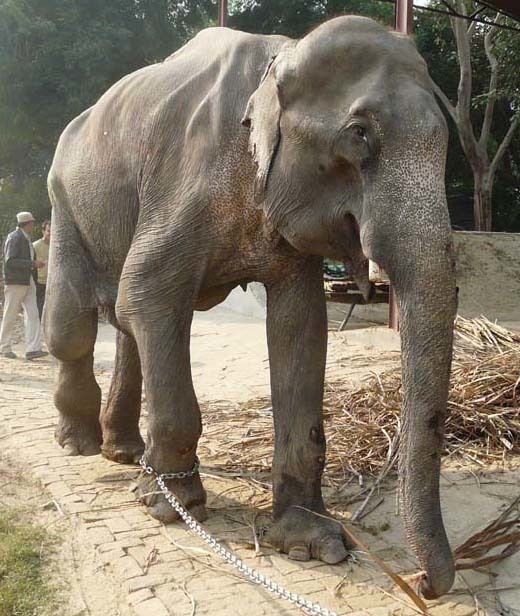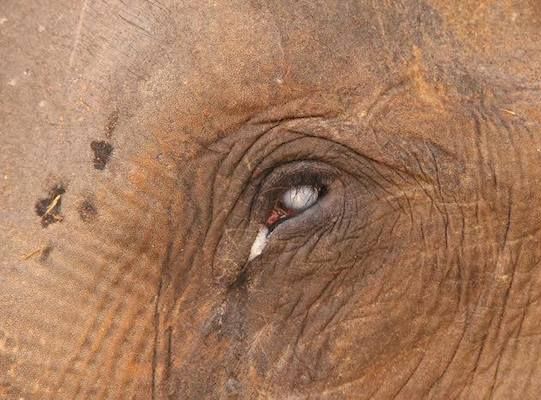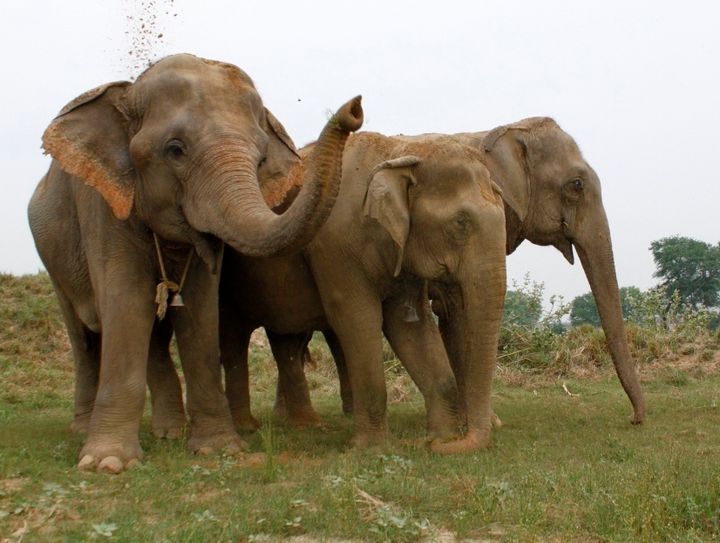Bhola the elephant was out on a typical work day for his owner along a a hot, busy urban street when a massive truck hit him. Injuries to his spine, back, and shoulders — even his trunk — took months to even partially heal. Suzy had an equally terrible life as a working elephant: blind in both eyes from neglect and trauma, chained up when she wasn’t performing for the small circus in southern India that “owned” her. Today, both elephants are in recovery at the Wildlife SOS Elephant Conservation and Care Center in Mathura, India. Both were victims of a trade that relies on capturing wild elephants and forcing them into lives of labor — a sordid practice whose time has come.

Bhola in work chains. The 45-year-old elephant was severely injured after being hit by a truck while walking a busy highway for his owner.
Owning an elephant in India remains a status symbol. While elephants are revered in the country, the grim reality for captured elephants is a miserable one. Taken from jungles with large swaths of land through which to roam, captured elephants in India end up in all manner of unnatural settings: in circuses, chained to small areas in temples, walking on scorched city tarmac as beggars for their masters, hauling heavy loads or cheap rides for tourists, on and on. The time has come to stop ripping elephants from their natural environment in India’s wilderness. The reasons are twofold: 1) the effect of this practice on wild elephant populations, and 2) the inhumane treatment that captured elephants are forced to endure.
The most recent International Union for Conservation of Nature (IUCN) Red List account for Asian elephants (2008) puts the number in India between 26,390 and 30,770. This makes up between 60% and 70% of the world’s total Asian elephant population — a number that has been dwindling since the IUCN’s assessment. The ongoing decline is due to a variety reasons, including habitat loss and human conflict. However, even as the wild elephant population numbers continue to plummet, the overwhelming majority of “working” elephants in India are being taken from the wild. It’s all the more troubling because this species is listed as Endangered on the Red List.
Impacts to wild populations aside, we still have the issue of inhumane treatment of captured elephant, starting with how the little ones are taken from their mothers in the wilderness, only to be placed in camps where they endure beatings and other forms of mistreatment in an effort to “break their spirits” (i.e., render them “safe” to be around humans). The situation often goes from bad to worse once these elephants are sold; most mahouts (elephant trainers) control the animals through the infliction of pain and intimidation. And even if they are not regularly beaten, captured elephants are seldom taken care of in the manner that they need; an experienced mahout with knowledge and training of an elephant’s needs must be on hand at all times. The elephants need a proper diet, as well, and this is expensive. As such, captured elephants can have less-nutritional diets than their wild counterparts — when they get to eat at all; in fact, most of these elephants are malnourished. Last but certainly not least, regular veterinary care must be provided to captive elephants. This care should include regular visits by a veterinarian and daily upkeep and treatment of an elephant’s feet (which, by the way, did not evolve to walk on hot pavement). But sadly and unsurprisingly, most captured elephants seldom, if ever, get the veterinarian care they need. The bottom line is this: Taking care of any elephant is difficult and expensive — and most captured elephants, even if they are not beaten, are still neglected.

Close-up of Suzy, a 67-year-old elephant who went blind as a result of neglect and mistreatment in an circus.
As mentioned, captured elephants are frequently rented out and/or overworked. Many are forced to labor under harsh and unsafe conditions, made to walk hot roads that damage their feet and put them in danger of being hit by cars and trucks, forced to carry heavy loads that strain their bodies, and so on. Moreover, many of them have suffered injuries from neglect and mistreatment. Even the most experienced mahouts often employ cruelty, violence, and intimidation to make elephants comply with their wishes. These majestic animals are put in spiked chains, prodded with bull-hooks and spears, screamed at, and otherwise threatened. Circus elephants are physically beaten to learn painful and humiliating tricks, and other working elephants are simply beaten as a means of control.

Suzy today, in between her friends Asha and Lakhi.
There are also aspects of elephant behavior that simply do not jibe with the way captured elephants are usually kept. For example, female elephants are extremely social animals, and to be psychologically healthy they must have the company of other female elephants. This is not always available in captive-elephant scenarios in India. And though adult males are more solitary by nature, their captivity is complicated by a biological condition called musth, a periodic condition characterized by a rise in reproductive hormones and aggressive behavior. When males go into musth, they can be extremely difficult to handle, which often results in merciless beatings as a method of control. Males in musth — and sometimes not in musth — can even go on rampages that kill people.
In summary, the great majority of elephants captured from the wilderness in India end up in lives like Bhola and Suzy once had, lives of needless suffering. When they actually do get enough to eat, their diets are usually sub-par, nutritionally. They suffer from a lack of quality veterinary care, and they’re often overworked and/or beaten. Female elephants are usually isolated from other females, which is difficult for them emotionally, and males are intentionally deprived of food and water while in musth. Even experienced mahouts often inflict great physical and psychological duress upon these animals. On top of all that is the trauma suffered by young elephants when they are forcefully taken from their mothers in the wilderness, which further reduces wild populations of an already endangered species in India.
The data are clear, and the choice is obvious. The time has come to end the practice of capturing wild Asian elephants in India. The time has come to leave them alone.
